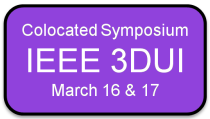- Home
- Program
- Presenter Info
- Call for Participation
- Venue
- Registration
- Committees
- Past Conferences
- IEEE 3DUI 2013
- ACM i3D 2013
Doctoral Consortium
Anamary LealVirginia TechVirginia Polytechnic Institute and State University, USA
Title:Flexible Input for 3D Surface Design
Abstract:Designing three-dimensional (3D) surfaces is difficult in both the physical world and in 3D modeling software, requiring background knowledge and skill. The goal of this work is to make 3D surface design easier and more accessible through natural and tangible 3D interaction, taking advantage of users' proprioceptive senses to help them understand 3D position, orientation, size, and shape. We hypothesize that flexible input based on fabric may be suitable for 3D surface design, because fabric can be molded and folded into a desired shape, and because it can be used as a dynamic flexible brush for 3D sketching. We developed Fabric3D, an interactive surface design system based on 3D sketching with flexible input, and conducted a longitudinal five-part study to test this hypothesis. We discuss our proposed research, in which we will explore more types and applications of flexible input and develop a design framework so that interaction designers can explore the potential of flexible input.
Andrew RobbUniversity of Florida, USA
Title:In Situ Training with Virtual Team Members: How Team Composition and User Personality Influence the User Experience
Abstract:Team training is one important application of virtual humans. Successful team training programs are becoming an important part of many continuing educational curriculums; virtual humans can potentially be used to reduce barriers preventing team training from becoming more widely spread. Little research has been conducted which explores how users respond to virtual humans in a team setting. Understanding how users respond to virtual humans in simulation is important if successful team training scenarios are to be developed. We present a research plan which aims at investigating how a user’s experience while training with virtual humans is influenced by two factors: the user’s personality and the composition of the team, with respect to the agency of the team members. We also present a report on the work which has already been completed, including a set of studies exploring how virtual humans can be used with in situ team training simulations and a study which provides support for the importance of considering user-specific factors.
Bret JacksonUniversity of Minnesota, USA
Title:Spatial Human-Computer Interaction Techniques for Visualization and Art
Abstract:In the next five years, major advances in low-cost tracking technology and the availability of commodity 3D displays will increasingly enable the use of desktop immersive virtual reality applications in offices and homes around the world. Yet one of the most challenging problems in the wide-spread adoption of these desktop virtual reality technologies is effective interaction with the complex three or four dimensional data they so often contain. To realize this vision, new spatial user interfaces must be created that enable the same level of control and accuracy that is experienced when interacting naturally in the physical world. This dissertation explores a new paradigm of computational tools that support a more refined, expressive, and accessible form of 3D input. Specifically, the completed work has shown that both passive and active haptics can improve control and accuracy of 3D user interfaces(3DUI) within immersive virtual reality visualizations. Based on this completed work, my proposed work targets a better understanding of the tradeoffs inherent in different types of haptic feedback when applied to a more complex example, specifically a complete 3D sketch-based modeling system.
Esubalew BekeleVanderbilt University, USA
Title:Interactive Robotic and Virtual Reality Technologies with Potential Applications in Autism Therapy
Abstract:This paper outlines a research project on designing adaptive interactive robotic and virtual reality technologies and evaluating their effectiveness in assisting traditional autism therapy. Autism Spectrum Disorders (ASD) are characterized by atypical patterns of behaviors and impairments in social communication. Traditional intervention approaches often require intensive behavioral therapy and depend on accessibility of well-trained therapists to address core deficits areas resulting in large familial and societal costs. Interactive robotic as well as virtual reality (VR) technology hold potentials in assisting traditional intervention. Robot-mediated and VR-based systems have been developed and evaluated as part of this project addressing the core areas of joint attention in young children with ASD and facial expression recognition in adolescents with ASD. Preliminary findings suggest that interactive technology can be helpful in assisting traditional therapy. Adaptive multimodal social interaction VR platforms and Robot-mediated imitation learning system are being built as future extensions of this research project work.
Nicholas KatzakisOsaka Univ, Japan
Title:It’s OK to be Shallow: 3D Interaction from a Distance for Education and Collaboration on Large Displays
Abstract:Large displays are especially important in education and collaboration as they allow for multiple users to simultaneously view and interact with the same contents. Although 2D control has been well studied, standing at a distance from a display and interacting in 3D still remains a complicated problem. Motivated by this, we introduce 3 novel techniques for manipulating 3D objects in front of a large display. Plane-Casting, a technique in which a 3-DOF tracked touch pad is used to control the position of a cursor in 3D, and two other techniques based on ray-casting that work in a laser-pointer like fashion. In a pilot study, Plane-Casting was characterized as intuitive by the participants while the ray-casting based techniques performed well when put up against a state-of-the-art direct interaction technique.
Peter C. WeirUniversity of South Australia, Australia
Title:Measuring Presence in Augmented Reality Systems
Abstract:Advances in technology have enabled the development of sophisticated systems that display real and virtual objects aligned with each other, termed Augmented Reality (AR). AR systems that run interactively and in real time, using high quality graphical displays and sensational cues, can create the illusion of virtual objects appearing to be real. Much work has been done to demonstrate presence in virtual environments, however the majority of investigations have been with Virtual Reality (VR) systems. Very few investigations have been done on AR systems, and even fewer on AR systems using video see-through head-worn displays (VSTHWDs). The research questions I want to investigate in the domain of Augmented Reality are: How can presence be measured objectively? How do individual subject differences in cognitive abilities and personality characteristics, affect presence? How do different levels of presence affect an individual’s perception of multimodal stimuli? Work done in my Masters Thesis, “Evaluation of Psychophysical Effects in High Quality Augmented Reality Environment”, provides the basis for extended research. The findings of this research will be of interest to cognitive science and experimental psychology, as they provide further insight into perceptive and cognitive processes.
Rustin Deane WebsterUniversity of Alabama at Birmingham, USA
Title:Corrosion Prevention and Control Training in an Immersive Virtual Learning Environment
Abstract:The majority of corrosion prevention and control (CPC) educational training is done through traditional pedagogy. The proposed research is an educational group comparison study investigating CPC educational training utilizing 2D multimedia and an immersive virtual learning environment (VLE). The research study is being sponsored by the U.S. Army Aviation and Missile Lifecycle Command (AMCOM) Corrosion Program Office. The research study and the developed research instruments (e.g. questionnaires, interview script, and exams) have been approved by the University of Alabama at Birmingham’s Institutional Review Board (IRB) and reviewed by the U.S. Army Human Research Protections Office (AHRPO). The principal investigator (PI) has completed the required course work and comprehensive exams in the Interdisciplinary Engineering PhD program and has been granted doctoral candidacy. Significant progress has been made towards the introduction, literature review, and methodology sections of the PI’s future dissertation. The base virtual reality system (e.g. output device, input device, tracking system, and virtual reality software toolkit) and related components have been purchased. Preliminary educational training resources and content for the immersive VLE have also been researched, collected, and/or created.
Tessa HawkinsUniversity of Nottingham, UK
Title:Designing 3D Virtual Environments for Effective Learning
Abstract:This doctoral research aims to analyze the development of 3D Virtual Learning Environments (VLEs), to better understand how Virtual Environment technology can be used to meet educational objectives, and to provide guidance about how to develop 3D VLEs. Several case studies are examined to inform this research.

























